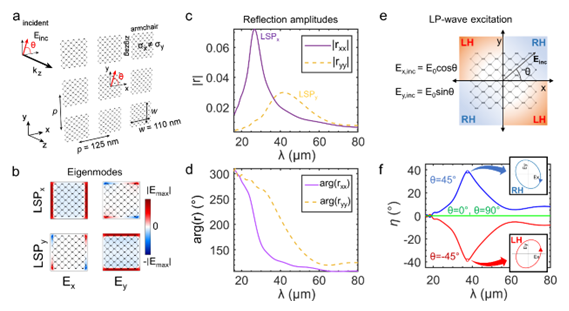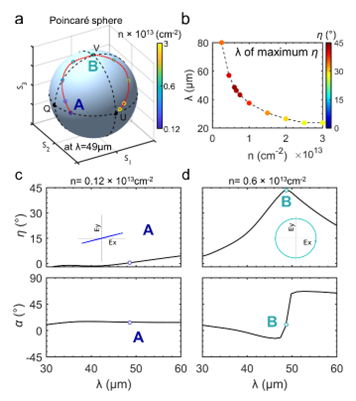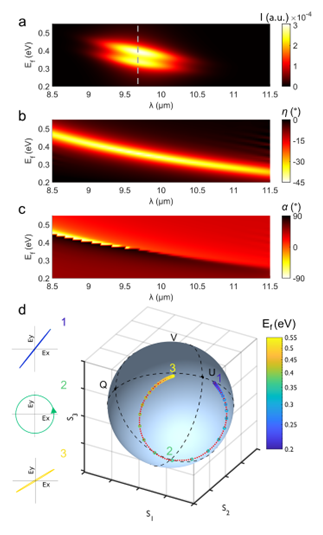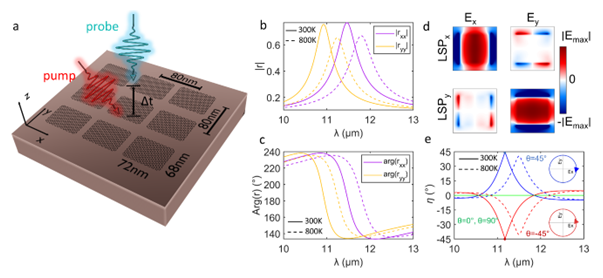Search
CLOSEOptical fibers with metasurfaces or plasmonic nanostructures
Dr. Georgios Kakarantzas
Optical Fiber Devices and Sensors
- Fabrication and hybridization of optical microfibers
- Hybrid Photonic Crystal Fibers (HPCFs)
- Optical fibers with metasurfaces or plasmonic nanostructures
Twisting Light with 2D Materials: Dynamic Chirality Control from the Atomic Scale Up
Why Control Chirality?
Chirality—the “handedness” of light—describes whether its electric field rotates clockwise or counterclockwise as it propagates. This property, once considered a niche concern in optics, has become central to modern photonic technologies:
- Chiral biosensing: Many molecules are chiral and selectively detecting them requires circularly polarized light.
- Quantum information: Encoding qubits in light’s helicity opens new pathways for robust, secure communication.
- Valleytronics and spintronics: In materials like TMDCs or topological insulators, chirality is the key to unlocking valley or spin selectivity.
- Advanced imaging: Circular dichroism imaging and contrast enhancement rely on precise polarization control.
Traditionally, chirality is manipulated with large, slow components—quarter-wave plates, birefringent crystals, or mechanical rotators. But what if we could control light’s twist faster than any mechanical system and thinner than any lens?
Thanks to 2D materials like graphene and black phosphorus, we now can.
Building the Future: Chirality Control with Atom-Thin Structures
Our recent research demonstrates that chirality control can be programmable, ultrafast, and fully integrable using metasurfaces engineered from single layers of graphene and black phosphorus. These nanostructures are not just small: they’re active, responsive, and tailored for the THz and mid-IR spectrum, where traditional components often fall short.
Below, we highlight three breakthrough studies that together form a complete narrative—from fundamental thermal dynamics to tunable devices and ultrafast chiral switches.
1) Electrically Tunable Chirality with Black Phosphorus Metasurfaces
Reference: Dynamic Control of Light Chirality with Nanostructured Monolayer Black Phosphorus for Broadband Terahertz Applications
Nikolaos Matthaiakakis, Sotiris Droulias and George Kakarantzas
Advanced Optical Materials, 10, 2102273, (2022)
Concept
Black phosphorus (BP), a highly anisotropic 2D material, is patterned into symmetric nano-squares. Although the pattern looks symmetric, BP’s intrinsic directional properties split the plasmons along with its crystal axes. These can interfere to generate arbitrary polarization states.

By applying a gate voltage, the spectral positions of these modes are shifted independently, enabling dynamic, broadband control of light’s polarization state, including conversion between linear and circular polarization.

Why It Matters
- No mechanical movement or rotating optics
- Entire device is only a few nanometers thick
- Programmable chirality across a wide THz band
Technical Highlights
- Spectral Range: 30–80 µm (THz regime)
- Conversion: Linear ↔ Circular, Left ↔ Right
- Modulation: Controlled with simple electrostatic gating
- Enhancement: Up to 6× boost in spontaneous emission at plasmonic hotspots
Applications
- On-chip polarimetric sensors
- Dynamic circular polarizers for terahertz communication
- Enhancing quantum emitter interactions in the THz domain
2) Third-Harmonic Generation in Plasmonic Graphene Metasurfaces
Reference: Dynamic Control of Nonlinearly Generated Light Chirality with Nanostructured Graphene
Nikolaos Matthaiakakis, Sotiris Droulias and George Kakarantzas
ACS Appl. Opt. Mater. 1, 952 (2023)
Overview
This study reports the first experimental demonstration of third-harmonic generation (THG) in an actively tunable graphene plasmonic metasurface operating in the mid-infrared. By exploiting strong light confinement and resonant enhancement in graphene nanoribbon arrays, the metasurface exhibits robust nonlinear upconversion of incident light into the near-infrared, enabled by graphene’s high third-order optical nonlinearity and its strong dependence on carrier density.
Unlike conventional THG platforms relying on bulk materials or multilayer structures, this work demonstrates efficient frequency conversion using only a single layer of graphene, showing that nanoscale field enhancement and ultrathin design can enable compact, reconfigurable, and scalable nonlinear photonic devices.

Mechanism: Plasmon-Enhanced Nonlinear Frequency Conversion
- Mid-IR Excitation at Plasmonic Resonance
The metasurface is patterned to support a localized plasmon mode at the mid-IR pump wavelength (~11.3 µm). The incident light excites this mode, generating strong in-plane fields confined to the graphene ribbons. - Third-Order Nonlinear Response of Graphene
The enhanced local fields induce a third-order polarization P(3)∝χ(3)E3P^{(3)} \propto \chi^{(3)} E^3P(3)∝χ(3)E3 in the graphene, resulting in coherent radiation at the third harmonic (~3.77 µm). The nonlinear susceptibility χ(3)\chi^{(3)}χ(3) arises from the intraband dynamics of Dirac fermions and is significantly boosted near resonance. - Doping-Dependent Efficiency
By tuning the Fermi level via electrical gating, the resonance condition and carrier population are adjusted, directly influencing the amplitude and spectral shape of the THG signal. - Polarization and Angular Dependence
THG emission is strongest under TM-polarized excitation and exhibits distinct angular patterns, confirming the anisotropic nature of the nonlinear response.

Experimental Observations
| Parameter | Value / Observation |
| Graphene platform | Monolayer CVD graphene on SiO₂ |
| Structure geometry | Nanoribbon array, periodicity: 750 nm |
| Fundamental pump wavelength | λ ≈ 11.3 µm (mid-IR) |
| Third-harmonic output | λ ≈ 3.77 µm (near-IR) |
| Peak THG power (pulsed) | ~30 pW |
| Peak THG conversion efficiency | ~10⁻⁸ |
| Modulation with doping | THG increases with EF from 0.3 to 0.5 eV |
| Key observation | THG enhancement at plasmonic resonance |
3) Ultrafast All-Optical Control of Light Chirality Using Nanostructured Graphene
Reference: Ultrafast All-Optical Control of Light Chirality with Nanostructured Graphene
Nikolaos Matthaiakakis, Sotiris Droulias and George Kakarantzas
Advanced Optical Materials, 12, 2303181, (2024)
Overview
This study demonstrates the first ultrafast, all-optical control of light chirality in a monolayer graphene metasurface by exploiting the non-equilibrium dynamics of hot carriers. Without any external gating, the experiment shows that femtosecond mid-infrared optical pumping can modulate both the ellipticity and handedness of the polarization of reflected light within picosecond timescales.
The metasurface design consists of geometrically symmetric graphene nanostructures, yet the observed chirality control arises dynamically from the nonlinear phase and amplitude evolution of orthogonal plasmonic modes—highlighting the emergence of optical chirality as a thermal, ultrafast effect in 2D materials.

Mechanism: Hot-Electron-Induced Modulation of Mode Interference
- Femtosecond Optical Excitation
A mid-IR pump pulse rapidly increases the electron temperature in graphene (Te > 1500 K), initiating a transient, non-equilibrium state. - Differential Redshifting of Plasmon Modes
The metasurface supports two weakly coupled plasmonic modes along orthogonal directions. Elevated Te reduces the Drude weight, resulting in non-uniform redshifting and broadening of these modes. - Phase & Amplitude Evolution
The dynamic spectral reshaping alters the relative phase and amplitude of the two modes—modulating the polarization state of the reflected probe light. - Emergent Chirality and Switching
This phase interference effect manifests as a transient change in ellipticity and handedness, enabling a reversible switch between left-handed and right-handed elliptical states on a sub-10 ps timescale.

Key Observations
| Parameter | Observation / Value |
| Graphene pattern | Square nanostructures (~430 nm) on SiO₂ |
| Pump wavelength | ~12 µm (mid-IR), 100 fs pulse |
| Max electron temperature (Te) | ~1750 K |
| Polarization modulation | Handedness reversal (Δχ ≈ 1.4) |
| Switching time | <10 ps (carrier-lattice thermalization) |
| Simulation model | Time-resolved FDTD with σ(ω, Te) from theory |
| Tuning mechanism | Purely optical (no gating required) |
Integration Roadmap: A Complete Toolbox for Dynamic Polarization Control
| Feature | BP Metasurface | Graphene Nanorectangles | Graphene Ribbons |
| Trigger | Voltage (slow) | Femtosecond laser (fast) | THz pulse (FEL) |
| Response Time | µs–ms | Sub-10 ps | ~10 ps |
| Spectral Range | 30–80 µm (THz) | 10–13 µm (mid-IR) | 9.4 THz |
| Polarization Control | Arbitrary (via gating) | Ultrafast switching | Nonlinear absorption |
| Device Thickness | Few nm (monolayer + oxide) | Monolayer | Few µm ribbon arrays |
Beyond the Chip: Metasurfaces Meet Optical Fibers
While much of the excitement around 2D metasurfaces centers on chip-based photonics, their ultrathin, flexible, and planar nature makes them ideally suited for integration with optical fiber systems—a step that bridges cutting-edge nanophotonics with widespread fiber-based infrastructure.
Why Fiber Integration Matters
- Compact integration: 2D metasurfaces can be directly transferred onto fiber tips or embedded into connectors.
- Distributed functionality: Add polarization control or switch anywhere along the fiber.
- Remote deployment: Ideal for sensing, communications, and mid-IR diagnostics in harsh or remote environments.
- Broadband and ultrafast: Compatible with both THz and mid-IR fiber links, including hollow-core, D-shaped, or side-polished fibers.
Practical Integration Pathways
- Direct transfer onto flat or angled fiber tips
- Embedding onto side-polished fiber sections for evanescent coupling
- Placement at fiber junctions (e.g. FC/PC connectors or spliced modules)
- Encapsulation in micro-optics or endoscope-type probes for biomedical uses
These approaches allow metasurfaces to operate not just in free space or on wafers—but as fully integrated components in fiber-optic sensors, communication nodes, and nonlinear light sources.
Looking Ahead
We envision metasurface-enabled fibers that:
- Dynamically convert linear ↔ circular polarization
- Provide ultrafast switching for quantum-secure communication over fiber
- Enable compact, fiber-based THz imaging systems
- Deliver on-chip and in-fiber chirality control in the same hybrid photonic network
Whether you’re working on fiber-integrated sensors, mid-IR spectroscopy, or reconfigurable communication backbones, these metasurfaces offer a new degree of control over light—right at the interface of silicon, graphene, and glass.
Optical Fiber Devices and Sensors
- Fabrication and hybridization of optical microfibers
- Hybrid Photonic Crystal Fibers (HPCFs)
- Optical fibers with metasurfaces or plasmonic nanostructures
